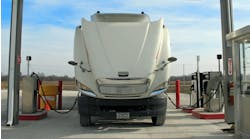Prompted by federal regulations, engine manufacturers have created systems and methods to reduce emissions in four primary categories: particulate matter, hydrocarbons, carbon monoxide, and nitrogen oxide (NOx). While the exact numbers of emission reductions don’t matter to the fleet operations, fleets must be aware of the different technologies and how design and functionality may change.
A number of new engine and emissions system technologies are on the horizon to help further improve vehicle efficiency while continuing to enhance powertrain performance.
The aftertreatment system in particular is an integral part of the powertrain, designed especially to help reduce greenhouse gas (GHG) emissions. The aftertreatment system is made up by a number of segments, including an exhaust gas recirculation (EGR) system to reduce emissions through the collection of PM and soot – most often collected via the diesel particulate filter (DPF); a diesel oxidation catalyst (DOC) to reduce hydrocarbons and carbon monoxide output; and the select catalytic reduction (SCR) system to reduce NOx. The SCR catalyst uses diesel exhaust fluid (DEF) in order to operate effectively.
The aftertreatment system is often subject to additional challenges for fleets running at lower speeds or in urban environments. This is because the numerous systems work together most effectively at hot operating temperatures that are hard to reach in certain duty cycles.
Thermal management engine technologies in development today may help to optimize engine combustion, improve air handling, reduce friction, improve catalytic aftertreatment technologies, and waste heat recovery - even for low-speed or low-load applications.
Passive thermal management designs aim to address changes to the aftertreatment system through using lighter weight materials, insulation techniques, restructuring system designs to place components working in unison closer in proximity to one another (moving the turbocharger closer to the SCR inlet, for instance), and considerations using the same substrate across all three aftertreatment systems – the DOC, DPF, and SCR.
Active thermal management refers to improvements to the actual process of emissions reduction while the vehicle is in operation. Some examples of active thermal management include engine throttling, heated aftertreatment systems, and flow bypass filters.
A variety of technologies are currently in developmental or testing phases to determine their viability on the next generation of heavy duty diesel trucks.
Variable valve actuation
Variable valve actuation (VVA) is a modular design approach integrated into the valvetrain. VVA works by adjusting the timing on one or more of the engine intake valves or exhaust valves.
The VVA capsule is controlled through oil pressure, according to Dr. Mihai Dorobantu, director of technology planning and government affairs for vehicle power management provider Eaton Corp.
“It’s one technology that – depending on how it’s integrated into the valvetrain – allows you to modify the timing, or the lift, of the [intake or exhaust] valves, or to deactivate the valves completely,” Dr. Dorobantu explains. “It’s an oil-controlled capsule that modifies the amount of movement being transmitted from the camshaft to the valve itself. It modifies the way the valve [operates] with respect to the camshaft.”
Because these valves are oil-controlled, it is imperative engine oil checks, proper oil change intervals are completed, along with using the appropriately specified engine oil weight and viscosity for these next generation engines.
Modified timing of the valves means they could be opened earlier or later – this refers to an early intake valve closing (EIVC) and late intake valve closing (LIVC) respectively. The third modification, cylinder deactivation (CDA), means the valves would close off the cylinder completely.
In other words, these valves assist to limit the number of cylinders operating at a given time. This method can help to periodically restrict airflow to the engine, raising the temperature in the still-operating cylinders. This process can be particularly beneficial at low speeds and/or low loads. This allows the SCR catalyst to reach a high enough operating temperature more quickly, initiating the aftertreatment process sooner.
“The goal of this is primarily to reduce the sub-volume of the engine – so you have a 6-cylinder turning into a 3-cylinder engine. You’re no longer pumping that much air through the system [and] you no longer have to combust that much air at a low load or idle condition. The remaining cylinders that are sweeping air can now be raised to a slightly higher load, raising the temperature. That keeps the aftertreatment system hot,” explains Robb Janak, director of new technology for Jacobs Vehicle Systems. Known traditionally for the development of its “Jake brake” engine brake, Jacobs Vehicle Systems develops and manufactures commercial vehicle retarding and valve actuation technologies.
VVA technology can also offer additional engine braking power, which is especially important at a time when changes to vehicle design and function have improved the operating efficiency of the vehicle. Aerodynamic fairings and body designs, lower rolling resistance tires, coupled with a lower engine displacement volume capacity (from 15L to 12L, for instance) and downspeeding impact the stopping distance of a heavy duty truck using today’s engine braking technology.
“We used to cruise at 1,400 or 1,500 rpm; now we’re down to 1,100 rpm,” Dr. Dorobantu advises. “We’re talking about, in the future, cruising at 1,000 rpm, or sub-1,000 rpm. That means fewer and fewer engine compression strokes happening.”
Jacobs Vehicle Systems has also been working to address these concerns, with the development of the company’s High Power Density (HPD) engine brake.
“By having the HPD two-stroke engine brake, that allows us to get that second compression release with every revolution,” explains Janak. “You can improve the performance [of the engine brake] at those lower engine speeds.”
Making a business case for these technologies can be the biggest hurdle to overcome as new products are released to the market. This is why, Dr. Dorobantu believes, it’s important to have multiple functionalities for a technology in order to see the return on investment.
“CDA is mainly thought of as a NOx reduction technology,” Dr. Dorobantu says. “It’s very hard to put a price on NOx reduction. It’s important from a regulatory perspective, and from a societal perspective. But from a freight efficiency perspective, NOx does not have an economic business case. But, if the same CDA technology is also now part of the high-capacity engine brakes which enable significant CO2 reductions… now there’s a positive economic value to the same CDA technology.”
“We have invested our efforts to try to make sure we have simultaneous CO2 and NOx reduction and that we can actually provide a positive value proposition for the NOx reduction – making fuel economy help pay for the NOx reduction technology,” Dr. Dorobantu adds.
Possible updates to the SCR system
The Cleaner Truck Initiative (CTI), a proposal for rulemaking introduced in January of 2020, aims to create regulations that will further reduce NOx emissions beyond the previously set standards, and establish separate standards from the current Phase 1 and Phase 2 regulations.
Considered a passive thermal management strategy, a dual SCR system, also referred to as a parallel SCR system, may help address this. Dual SCR systems have the same design as a traditional SCR catalyst, but an additional smaller SCR catalyst would be added to the aftertreatment system upstream near the turbocharger exhaust. Because of the closer proximity to the turbocharger, and subsequently, the engine, the smaller SCR system could heat up more quickly to allow diesel exhaust fluid to be injected more readily once the engine is initially started.
Experts are still working out the possibility of implementing this technology. Current designs may pose questions from a service perspective because the smaller SCR catalyst would be upstream from the DOC and DPF.
What to expect, sooner rather than later
Technologies fleets will see on late model trucks will be higher compression ratios and methods to improve combustion, such as component design improvements to control the placement of fuel during the combustion process, CDA, and lower engine displacement volumes. Turbochargers may become more readily implemented to provide additional power in downspeeding applications and at lower idling and cruising rpm. Changes to the aftertreatment system will also ramp up.
“Initially, there will be many small changes to improve friction, air management, and combustion efficiency,” advises Paccar Vice President Landon Sproull. Paccar is the parent company for Kenworth and Peterbilt trucks. “Advanced controls and even deeper powertrain integration will also provide benefits. Further out, increased electrification of major engine systems, advanced turbocharging concepts, and faster combustion are other technologies OE’s may turn to deliver increased performance and economy.”
“It will take more than one new technology to meet future targets, but there is an industrywide push to increase fuel efficiency from the powertrain, chassis, and cab, along with the trailer,” adds John Moore, product marketing manager, Volvo Trucks North America. “That will involve improvements such as faster ratios, more downspeeding, idle reduction technology, improved aerodynamics between tractor and trailer, enhanced 6x2 technology, lighter-weight components, and low rolling-resistance tires that meet demands for traction and longevity.”




